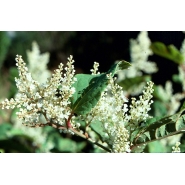1. What is Resveratrol ?
Resveratrol (3,4,5-trihydroxystilbene) is a phytoalexin and antibiotic produced naturally by various plants. In plants, it plays a defensive role against the aggressions of parasites and pathogens. Resveratrol can be present in simple or glycosylated form, which protects the molecule from oxidative degration and improves its intestinal absoption. Resveratrol occurs in two forms, cis and trans resveratrol, the “trans” isomer is the beneficial substance that is biological active.
2. How did people discover Resveratrol ?
Resveratrol has first possibly mentioned in Japanese in 1939 by M. Takaoka, who isolated it from the poisonous but medicinal Veratrum album.
Resvertrol was identified in the roots of a traditional Chinese and Japanese medicinal plant called Japanese knotweed or Polygonum Cuspidatum in latin, 1963.
In 1992, resveratrol came to scientific attention when Dr. Serge Renaud coined the phrase “French Paradox”. It has been observed that the French suffer a relative low incidence of coronary heart disease despite having a diet relatively rich in saturated fats. This led to research indicating that regular consumption of red wine might provide additional protection from cardiovascular disease.
Later, Dr. David Sinclair, a biochemist at the Harvard Medical School who focuses on studying the genetic components of aging, believed Resveratrol was very close to the anti-aging breakthrough and he had been searching for most of his life. Studies that he conducted in 2003 showed that resveratrol could significantly increase lifespan of yeast and worms. His research led him to study a normally inactive set of genes called Sirtuins (SIRT1). Previous studies on the life extension diet called Calorie Restriction showed that when these genes are activated they trigger a survival mechanism that can help fight off age related diseases, and possibly extend life. Dr. David Sinclair found that Resveratrol is able to activate these genes in humans.
3. Where can we find it ?
One of the most significant plants that resveratrol is found in is Polygonum Cuspidatum, a plant that has been used for centuries in Asia to treat heart and liver disorders. Others sources include Vaccinium family’s berries, commercial products such as red wine and grape juice.
4. What are the clinical implication of Trans Resveratrol ?
Cardiovascular protection
Resveratrol has been shown to prevent cardiovascular diseases by modulating the function of cardiac cells, inhibiting LDL oxidation, suppressing platelets aggregation and reducing myocardial damage during ischemia-reperfusion. It also modulates the metabolism and peroxidation of lipids and reduces the expression and activity of cycloxygenases.
Chemoprevention
Resveratrol has also been widely investigated for its chemopreventive effects, because it contracts the pathogenesis of tumors and the processes of angiogenesis and metastasis. The in vitro effects of resveratrol have been observed on various tumor cells, and generally involve an arrest of cell cycle and the induction of apoptosis.
Anti- inflammation
Reservatrol reduces tissue inflammation through the inhibition of lipoxygenases (LOXs) and cycloxygenases (COXs), which are responsible for the synthesis of leukotrienes and prostanoids, respectively, and also via the activation of NFkB and AP-1 nuclear factors and the reduction of superoxide production by NADPH oxidase.
Weight loss
Resveratrol has been shown to contrast obesity and insulin resistance induced by a hypercaloric diet in the mouse, due to a rise in the aerobic capacity induced by AMP kinase and PPAR1-alpha activation and an increase in the number of mitochondria.
Anti-neurodegeneration
Caloric restriction can prevent the pathogenesis of Alzheimer’s through the activation of the SIRT1 histone deacetylase. In murine models of Huntington’s disease and Wallerian degeneration, resveratrol has induced protective effects on neurons via SIRT1 activation, suggesting its possible use as an antineurodegenerative.
Skin protection
Resveratrol has a tightening and friming action on the skin and favors tissue renewal, thus acting similarly to retinol. The topical application of resveratrol to nude mice has protected the skin from phototoxicity and tumorigenesis induced by UV-B radiatios.
Resveratrol has also shown antimicrobial effects against bacteria and dermatophytes that infect the skin.
Resveratrol inhibit the enzyme tyrosinase, a limiting factor in the synthesis of melanin, thus suggesting their use in the treatment of hyperpigmentations. Another possible mechanism related to the depigmenting action of resveratrol concerns the inactivation of the microphtalmia-associated transcription factor (MITF), since the hyperactivation of this factor has been associated with cAMP-induced melanization of melanocytes.






























